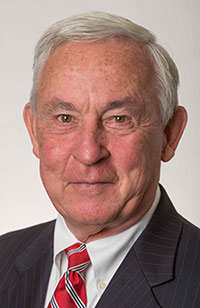Building ASME’s Foundation for the Future: Part Three
Building ASME’s Foundation for the Future: Part Three
July 14, 2017

To the ASME Community:
Greetings once again! Allow me to pick up where we left off last time in this third article of the series — I’m eager to continue sharing the story of this year as well as where I’m very pleased to say we’re heading.
As mentioned previously, the team effort to execute the new Enterprise Strategy adopted by ASME’s Governors last year is all about Building ASME’s Foundation for the Future. We are working to put the pieces in place which together will make for a cutting-edge Society for the 21st century.
As we finalize and commence implementation of the newly developed Integrated Operating Plan, which is based on the 10-3-1 (10 year—3 year—1 year) goals supporting our technology-based strategy, we knew it was vital to integrate our constituencies into the process. To make that happen, five Presidential Task Forces have worked unflaggingly in fiscal year 2016-17 to review the work ASME does on behalf of engineers in five critical areas: Industry Leadership Engagement; Strategy & Planning; Student & Early Career; Group Engagement/Alignment; and Building a High-Performing Board. They’ve looked both at how we do it and how we can do better. These teams have analyzed ASME’s strengths and challenges and, with the fiscal year now recently concluded, have been presenting their top recommendations for how ASME can raise its game in each of these areas as we implement the strategy and build our expanded prowess in each of the five priority technology areas. I’m excited to share each Task Force’s recommendations, which will form the basis of our game plan for the next chapter of the ASME story.
Sector Management Committee (SMC) Group Engagement/Alignment
The SMC Group Engagement/Alignment Task Force (chaired by Rick Marboe) was formed with the understanding that every stakeholder at ASME should be linked efficiently and effectively with all resources ASME has to offer, including support systems, access to resources, leadership opportunities, and support for their career path. In recent presentations to the BOG, the Group Engagement/Alignment Task Force argued that the best ways to make these more accessible will be:
- To create a group engagement organization to develop “rules of engagement” with Sectors and the Committee on Finance and Investment (COFI)to oversee training of groups for alignment with ASME mission and strategy;
- To institute new Group Leader training — along the lines of the previous Leadership Training Conference (LTC) and Volunteer Orientation & Leadership Training (VOLT) — to support leaders’ understanding of strategy, to communicate roles and responsibilities, and to create a common vocabulary for new business development;
- To create and deploy electronic or web-based tools for participants to “self-track” their interests, with regular updates phased in over time;
- To create a product and/or program development fund to seed development of new events, with a replenishment mechanism and minimum balance controlled by the Board of Governors.
Industry Engagement
The Industry Leadership Engagement Task Force (chaired by Stacey Swisher Harnetty) addressed a broad range of areas critical to ASME’s future success and vital to engaging industry leadership in ASME’s future: how to support and advance the five core technologies; product and standards development and training materials; optimal support for public events and conferences; determination of public policy priorities; optimization of work with academia; and how to build and optimize avenues of engagement for industry leaders around the world. Out of this universe of important work, the ILE Task Force believes that the highest-priority items must be:
- To bolster awareness of ASME and its work among global leaders in engineering by creating more industry-facing awards to recognize industry leaders and leading companies;
- To expand our leadership pipeline globally and strengthen the ASME team by forming regional or international Industry Advisory Boards (IABs) where we determine market opportunity is greatest and by targeting alignment and increased activity for specific local sections to those areas.
Student & Early Career Engagement
The Student & Early Career Engagement Task Force (chaired by ASME Past President Terry Shoup) took on the issues that are central to our future: how can we harness the energy and spirit of our Student and Early Career Engineers by creating and providing rich opportunities to make a difference for the world, to network with colleagues, and to find mentors and guidance for the path. With a total of over 30 recommendations, Terry’s team has offered three top recommendations which will be the first we implement:
- To redouble our efforts to understand the issues that are most important to our youngest members;
- To seek increased input and feedback on organizational leadership decisions;
- To institute flexible membership dues and dues incentives to improve and broaden our engagement of engineers in the early stages of career building.
Strategy & Planning
The Strategy & Planning Task Force (chaired by John Goossen) has led the way this year in determining what will be needed in a continuing way in order to implement the vision as articulated in ASME’s new strategy. For an organization like ASME, regular leadership turnover is a significant challenge to strategic continuity. The S&P Task Force has proposed three “deliverables” which I think will go a long way toward getting us there:
- The creation of an annual process for maintaining, updating and communicating ASME’s strategic plan to the wider ASME community;
- Instituting a “sustainable entity” to engage the board, staff, and volunteers on strategy development, monitoring and implementation; and
- Creating a mechanism or process by which the BOG can closely monitor ASME’s short-term and long-term progress towards each of its strategic goals.
High Performance Board of Governors
Last but surely not least, the Task Force for Fostering a High-Performing Board of Governors took on the re-engineering of what is arguably the central driver of all Society work. It is my own view that no organization like ours can achieve greatness without a governing body that operates at world-class levels. If we want to play at those levels competing with other global organizations that operate in our space, we simply have to start with a high-performing Board of Governors. This group, chaired by Bill Wepfer, articulated a set of six recommendations which, taken together, will contribute strongly to taking our Board’s functioning to that place:
- Improve speed, efficiency and clarity for all in-person Board meetings;
- Complete the full articulation of all Board roles and responsibilities;
- Improve the efficiency and effectiveness of the Board of Governors (BOG) and its committees’ operations and processes;
- Review and enhance BOG training for all current and incoming members, to improve individual members’ effectiveness;
- Review and improve the Board nominating process so as to evaluate and recruit the strongest possible Board candidates equipped with necessary skills, experience, and depth and perspective.
Overarching Goal: Unparalleled Opportunity in a Cutting-Edge Engineering Society
The grand challenge of all of this year’s work has been to safeguard the heart and soul of ASME while building the foundation for the future of ASME: strengthening our technology base in vital technologies, crafting new and enhanced programs, building our IT and other supporting infrastructure, and elevating the strength and effectiveness of our Board of Governors. One might say that we are working to build a vigorous hybrid: we seek to make a historic and successful professional-networking-learning Society even more successful by helping it become, at the same time, an agile, high-performing, technology-driven, customer-oriented organization inspired and guided by an historic mission.
As this transformative year in the life of our organization enters its next phase, I believe we are well on our way. The strategy/technology work, the development of the 10-3-1 Integrated Operating Plan, and the Task Forces have provided a unique platform this year to set us on the road to success towards our strategic objective to become the “go-to organization to address key technology challenges in the public interest.” The new leadership is in place and moving forward under President Charla Wise and our new Board of Governors. But to make it real, we’re going to need you. How will you be a part of ASME’s bright future? I hope you’ll be inspired to get involved and make a difference.
Thank you again for the honor of serving you this past year as your President.
With all my best wishes —
Keith Roe, ASME Immediate Past President
Read Part One and Part Two of Roe’s series on Building ASME’s Foundation for the Future.




